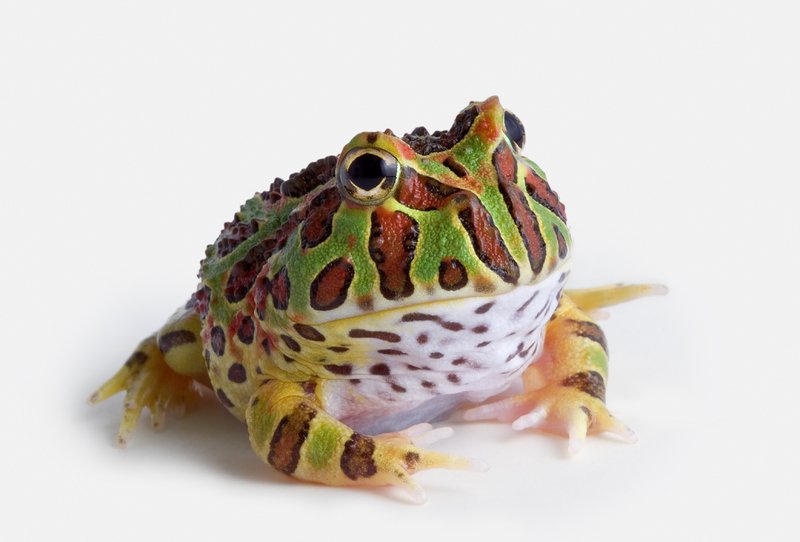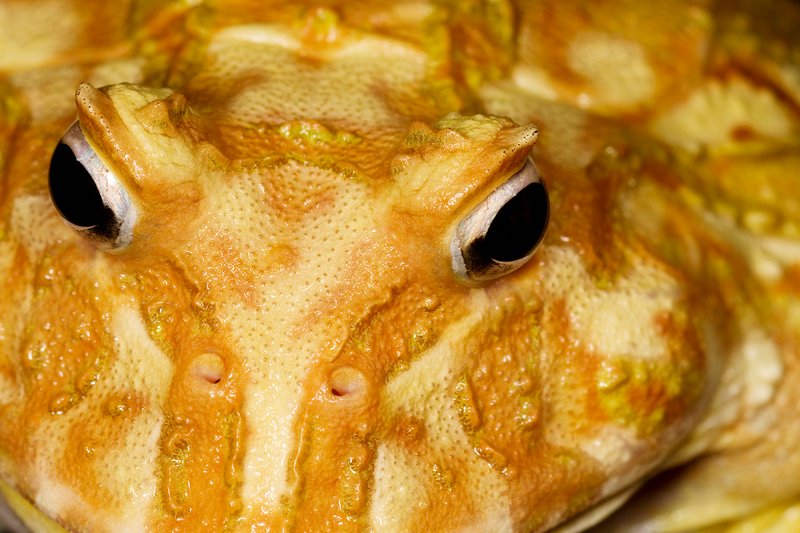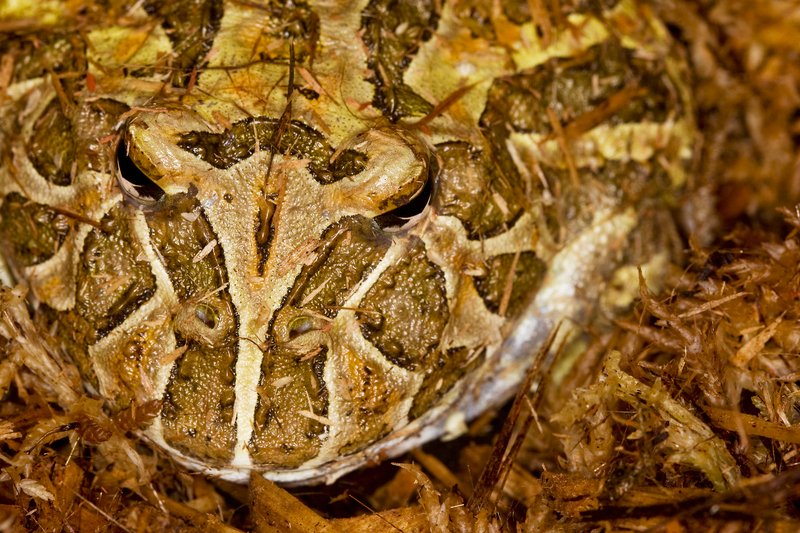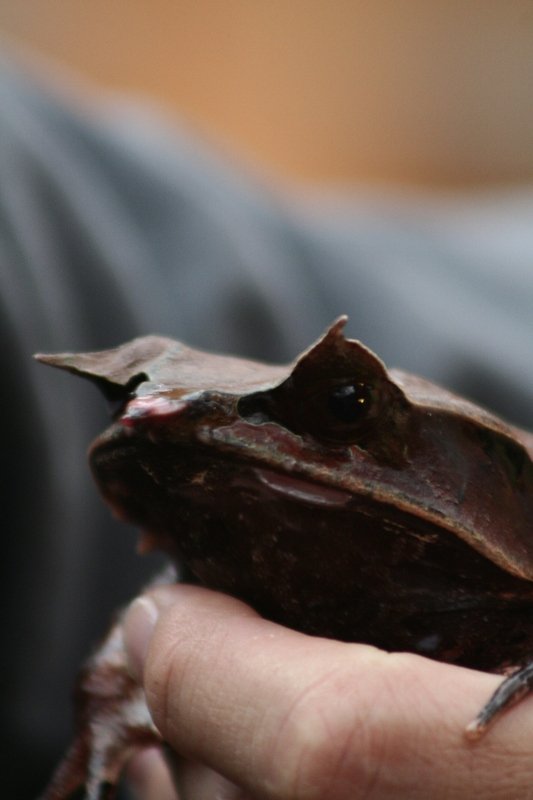Pacman frogs, also known as horned frogs. They are a fascinating species of frogs from South America. These frogs are known for their unique appearance, with a large, round body and a distinctive horn-like projection above each eye.
Whether you are a seasoned frog enthusiast or a newcomer to the world of amphibians, pacman frogs are definitely worth exploring further.
Discover Pacman Frogs and Their 50+ Types
There are several species of Pacman frogs (horned frogs) but the most commonly kept species in the pet trade is Ceratophrys ornata. There are also other species such as Ceratophrys cranwelli, Ceratophrys aurita, and Ceratophrys calcarata.
Exact numbers may vary depending on the taxonomic classification system used, but currently there are around nine recognized species of Pacman frogs.

What is a Pacman frog?
A Pacman frog is a unique and adorable amphibian belonging to the genus Ceratophrys. This frog, native to the moist subtropical areas of Central and South America, has an oversized head and big eyes, making it look like a tiny Pacman!
Its markings can vary in color from brown and gray to bright yellows, oranges, and even purples. The Pacman frog loves to eat insects and can also take other foods, like worms and even small pieces of fish. It’s a great pet choice for people with smaller living spaces who want to keep a frog.
Do Pacman frogs lay eggs?
Yes, Pacman frogs do lay eggs. Males often make mating calls to attract females, and those females can deposit up to two thousand eggs which are fastened to submerged plants.
Not long after the eggs have been placed, they hatch within a fortnight. It doesn’t take very long for the tadpoles to become adults – just a single month and then they have evolved into frogs.
Pacman Frog – Breeding
The Pacman frog, also known as Ceratophrys ornata, is a rather unusual looking species of frog that is found in a range of wetland habitats in South America.
They are typically very easy to breed and can usually reproduce from around one year old, once they reach a certain size. They lay their eggs in still or slow moving water, where the eggs will remain until they hatch. The adults provide no parental care to the offspring once they hatch.
In fact, they may even eat the newly hatched tadpoles if they are too small. Depending on the species of Pacman frog, they can live anywhere between 3 to 5 years in captivity.
Pacman Frog – Reproduction
The Pacman Frog is an interesting creature when it comes to reproduction. While these frogs can lay up to 1500 to 2000. It is the female that does all the work of caring for the eggs.
They carefully and patiently guard the eggs until they hatch, watching them night and day, as she fiercely defends her nest from any predators.
The mother may even consume the eggs if she feels the environment is too dangerous, a feat of nature’s powerful protection.
Once the eggs hatch, the tadpoles are fully independent from the parents and make their own way in the wild. This frog is a marvelous example of the incredible reproductive behavior of nature.
Pacman Frog – Eggs
Egg Structure
Pacman frogs lay hard-shelled eggs, known as ‘Amphibian Eggs’, which consist of a thin layer of jelly around a small, spherical, hard egg. These eggs measure approximately 4-7mm in size and are slightly elongated with ridged caps.
Egg Specification
Pacman frog eggs are mostly opaque but slightly translucent with small air-filled chambers, which keep them buoyant. When the eggs are fertile, the egg shells appear light-brown to tan in color, while unfertilized eggs will be transparent.
Egg Laying Process
When a Pacman frog is ready to lay her eggs, she will use her back legs to scoop up a handful of vegetation and moist soil, forming a nest in which to deposit her eggs.
The female Pacman frog then lays a cluster of 8-50 eggs in her nest, coating them with an additional layer of soil and moist vegetation to keep them safe from predators.
Where They Lay Eggs
The nest that the Pacman frog lays her eggs in can vary, but she typically selects shallow, slow-moving bodies of water like ditches, ponds, or pools. Pacman frogs also lay their eggs on land, as well as inside other objects such as logs, leaf-litter, or discarded items.
Hatching Process
The eggs hatch in 1-3 weeks after being laid and will usually stay in the nest until their skin hardens and dries. After hatching, the Pacman frog tadpoles will move to more shallow water with better access to food sources and the females may sometimes take the eggs in her mouth to help them hatch more quickly. Once they are fully-developed frogs, they can live up to 8 years in the wild.
Where do Pacman frogs lay eggs?
Pacman frogs lay their eggs in a moist environment such as damp soil, sand, or moss.
How many eggs do Pacman frogs have?
Pacman frogs can lay anywhere from 1000 to 2000 eggs, depending on the species. Usually, they lay around 50-500 eggs in a single clutch. It’s important to provide a substrate such as damp peat moss or sphagnum moss for the female Pacman frog to lay her eggs in.
After about one to two weeks, the eggs will begin to hatch and you will have some brand new baby Pacman frogs to care for!
What is the scientific name of the Pacman frog?
The scientific name for the Pacman frog is Ceratophrys Ornata.

Pacman frog lifespan
The Pacman frog has an average lifespan of 5 to 7 years in captivity. These frogs may even live for 10 years with the proper care, making them a great pet for a long-term commitment.
Additionally, if the Pacman frog has a healthy diet and good habitat conditions, it may have a much longer lifespan of 12 or even 14 years!
Pacman Frogs – Diet, Habitat, Location
Diet
Pacman frogs, also known as Ceratophrys Ornata, feed primarily on insects, small amphibians, earthworms, and smaller mammals. As ambush predators, they hide among leaves and rocks to catch unsuspecting prey that passes nearby.
They often forage for food at night, due to their sensitive skin making them susceptible to the bright sunlight.
Habitat
Pacman frogs can typically be found in slow-moving freshwater rivers and streams throughout central and northern South America. They often create burrows in wet, muddy riverbanks that allow them to remain cool and safe from predators.
During the dry season, they will often migrate to higher-altitude, moist grasslands and wetlands.
Location
Pacman frogs can primarily be found in the lowlands and mountainous regions of Argentina, Bolivia, Brazil, Colombia, Ecuador, Guyana, Peru, Suriname, Uruguay, and Venezuela. These regions are all home to humid, tropical climates, ideal for their survival.
What is the order and classification of the Pacman frog?
The Pacman frog, or Ceratophrys ornata, is a species of large, aggressive South American frogs belonging to the family Ceratophryidae. It is classified as an amphibian in the class Amphibia and is part of the order Anura.
What is the size of a Pacman frog?
A Pacman frog typically can range in size from 2 to 6 inches in length, with the average size falling at 4-5 inches long. Its weight can range anywhere from 60-120 grams.
They come in a variety of colors such as yellows, browns, and greens and more. They have bulging eyes and can inflate themselves to appear bigger if they feel threatened.
50+ Types of Pacman Frogs
A list of Pacman frogs that have been scientifically described with their scientific names and brief descriptions. It’s worth noting that the Pacman frog, also known as the Horned frog, is a common name for frogs belonging to the Ceratophryidae family. Here are 50+ types of Pacman frogs:
- Ceratophrys aurita – The Green Pacman Frog, the most common species of Pacman frog. They are large, have green or olive-colored skin with black stripes or spots.
- Ceratophrys cranwelli – The Chilean Pacman Frog, usually found in Chile, has greenish-yellow or brown skin with black or brown spots.
- Ceratophrys calcarata – The Argentinean Pacman Frog, has greenish-yellow skin with black spots, and a distinctive horn-like projection above each eye.
- Ceratophrys cornuta – The Horned Pacman Frog, has a horn-like projection on each eyelid and a large, round body with greenish-yellow or brown skin.
- Ceratophrys joazeirensis – The Joazeiro Pacman Frog, found in Brazil, has a large, round body with greenish-yellow or brown skin and black spots or stripes.
- Ceratophrys ornata – The Ornate Pacman Frog, has a round body with greenish-yellow or brown skin and black or brown stripes or spots.
- Ceratophrys stolzmanni – The Stolzmann’s Pacman Frog, found in South America, has a large, round body with greenish-yellow or brown skin and black spots.
- Ceratophrys testudo – The Suriname Horned Frog, has a round body with greenish-yellow or brown skin and black or brown stripes or spots.
- Ceratophrys aurulenta – The Golden Pacman Frog, found in South America, has a round body with golden-yellow skin and black or brown spots.
- Ceratophrys auratus – The Bronze Pacman Frog, has a round body with bronze-colored skin and black or brown spots.
- Ceratophrys cranwelli alvarezi – The Albino Chilean Pacman Frog, has a round body with white or cream-colored skin and red or pink eyes.
- Ceratophrys cranwelli cranwelli – The Normal Chilean Pacman Frog, has a round body with greenish-yellow or brown skin and black or brown spots.
- Ceratophrys cranwelli hypochondrialis – The Hypochondrial Chilean Pacman Frog, has a round body with greenish-yellow or brown skin and black or brown spots on the belly.
- Ceratophrys cranwelli noroccidentalis – The Northwestern Chilean Pacman Frog, has a round body with greenish-yellow or brown skin and black or brown spots.
- Ceratophrys cranwelli thorata – The Thorata Chilean Pacman Frog, has a round body with greenish-yellow or brown skin and black or brown spots on the back.
- Ceratophrys cranwelli venosa – The Veined Chilean Pacman Frog, has a round body with greenish-yellow or brown skin and black or brown spots with white or yellow veins.
- Ceratophrys dorsata – The Banded Pacman Frog, has a round body with greenish-yellow or brown skin and black or brown stripes on the back.
- Ceratophrys greeningi – The Greening’s Pacman Frog, has a round body with green or yellow skin and black or brown spots.
- Ceratophrys auriceps – The Yellow-headed Pacman Frog, has a large, round body with yellow skin on the head and black or brown spots on the body.
- Ceratophrys aurisaeta – The Yellow-striped Pacman Frog, has a round body with greenish-yellow or brown skin and yellow stripes on the back.
- Ceratophrys aurisulphurea – The Sulphur Pacman Frog, has a round body with sulfur-yellow skin and black or brown spots.
- Ceratophrys aurizonans – The Arizona Pacman Frog, found in Arizona, has a round body with greenish-yellow or brown skin and black or brown spots.
- Ceratophrys aurorae – The Aurora Pacman Frog, has a round body with greenish-yellow or brown skin and black or brown spots on the back and legs.
- Ceratophrys auriventris – The Golden-bellied Pacman Frog, has a round body with greenish-yellow or brown skin and golden-yellow belly.
- Ceratophrys aurivillii – The Golden Villi’s Pacman Frog, has a round body with golden-yellow skin and black or brown spots on the back.
- Ceratophrys boiei – Boie’s Pacman Frog, has a round body with greenish-yellow or brown skin and black or brown spots.
- Ceratophrys calcaratus – The Spiny Pacman Frog, has a round body with greenish-yellow or brown skin and spines on the back.
- Ceratophrys cornutus – The Spotted Horned Frog, has a round body with greenish-yellow or brown skin and black or brown spots on the back and legs.
- Ceratophrys cranwelli albolineata – The White-lined Chilean Pacman Frog, has a round body with greenish-yellow or brown skin and white stripes on the back.
- Ceratophrys cranwelli melanistic – The Black Chilean Pacman Frog, has a round body with black skin and red or pink eyes.
- Ceratophrys cranwelli patzcuarensis – The Patzcuaro Chilean Pacman Frog, has a round body with greenish-yellow or brown skin and black or brown spots.
- Ceratophrys cranwelli sanchesi – Sanchez’s Chilean Pacman Frog, has a round body with greenish-yellow or brown skin and black or brown spots on the back and legs.
- Ceratophrys cranwelli tilaranensis – The Tilaran Chilean Pacman Frog, has a round body with greenish-yellow or brown skin and black or brown spots on the back and legs.
- Ceratophrys cranwelli verde – The Green Chilean Pacman Frog, has a round body with green skin and black or brown spots.
- Ceratophrys cranwelli zebra – The Zebra Chilean Pacman Frog, has a round body with greenish-yellow or brown skin and black or brown stripes on the back and legs.
- Ceratophrys dubia – The Doubtful Pacman Frog, has a round body with greenish-yellow or brown skin and black or brown spots.
- Ceratophrys frenata – The Banded Pacman Frog, has a round body with greenish-yellow or brown skin and black or brown stripes on the back and legs.
- Ceratophrys hylidae – The Hylid Pacman Frog, has a round body with greenish-yellow or brown skin and black or brown spots on the back and legs.
- Ceratophrys joazeirensis zebra – The Zebra Joazeirense Pacman Frog, has a round body with greenish-yellow or brown skin and black or brown stripes on the back and legs.
- Ceratophrys ornata – The Ornate Pacman Frog, has a round body with greenish-yellow or brown skin and black or brown spots on the back and legs, and orange or red markings on the head.
- Ceratophrys stolzmanni – Stolzmann’s Pacman Frog, has a round body with greenish-yellow or brown skin and black or brown spots on the back and legs.
- Ceratophrys sulcata – The Furrowed Pacman Frog, has a round body with greenish-yellow or brown skin and a furrowed appearance on the back.
- Ceratophrys testudo – The Turtle Pacman Frog, has a round body with greenish-yellow or brown skin and black or brown spots on the back and legs, and a flattened appearance resembling a turtle shell.
- Ceratophrys vilarsi – The Vilar’s Pacman Frog, has a round body with greenish-yellow or brown skin and black or brown spots on the back and legs.
- Ceratophrys yei – Yei’s Pacman Frog, has a round body with greenish-yellow or brown skin and black or brown spots on the back and legs.
- Ceratophrys cranwelli gold – The Gold Chilean Pacman Frog, has a round body with golden-yellow skin and black or brown spots on the back and legs.
- Ceratophrys cranwelli bubblegum – The Bubblegum Chilean Pacman Frog, has a round body with bright pink skin and black or brown spots on the back and legs.
- Ceratophrys cranwelli mint – The Mint Chilean Pacman Frog, has a round body with mint green skin and black or brown spots on the back and legs.
- Ceratophrys cranwelli apricot – The Apricot Chilean Pacman Frog, has a round body with apricot-colored skin and black or brown spots on the back and legs.
- Ceratophrys cranwelli lavender – The Lavender Chilean Pacman Frog, has a round body with lavender-colored skin and black or brown spots on the back and legs.
- Ceratophrys cranwelli albino – The Albino Chilean Pacman Frog, has a round body with white or cream-colored skin and red or pink eyes.
- Ceratophrys cranwelli hypo – The Hypomelanistic Chilean Pacman Frog, has a round body with pale yellow or cream-colored skin and reduced black or brown markings on the back and legs.
- Ceratophrys cranwelli green – The Green Chilean Pacman Frog, has a round body with green skin and black or brown spots on the back and legs.
- Ceratophrys cranwelli strawberry – The Strawberry Chilean Pacman Frog, has a round body with bright red skin and black or brown spots on the back and legs.
- Ceratophrys cranwelli sunglow – The Sunglow Chilean Pacman Frog, has a round body with yellow or orange skin and reduced black or brown markings on the back and legs.
- Ceratophrys cranwelli sunburst – The Sunburst Chilean Pacman Frog, has a round body with bright yellow skin and black or brown spots on the back and legs.
- Ceratophrys cranwelli cinnamon – The Cinnamon Chilean Pacman Frog, has a round body with cinnamon-brown skin and black or brown spots on the back and legs.
- Ceratophrys cranwelli tangerine – The Tangerine Chilean Pacman Frog, has a round body with bright orange skin and black or brown spots on the back and legs.
These were some of the examples of Pacman frogs.
Can we keep Pacman frogs as pets?
Yes, you can keep Pacman frogs as pets! Pacman frogs are very popular due to their low maintenance and charming nature.
They do require a specialized environment in order to stay healthy, including warm temperatures and moist conditions, such as those provided by a terrarium with a large water bowl or aquarium with filtered water.
Additionally, it’s important to provide your Pacman frog with plenty of live insects and plants as they are predominantly insectivores.
Pacman frogs also need their own space to retreat and rest, so it’s a good idea to create several hiding places within the terrarium or aquarium. With the proper care and maintenance, your Pacman frog can be a fun, interactive, and rewarding pet.

How to feed pacman frogs?
Pacman frogs are small, cute creatures that make interesting and entertaining pets. They’re also relatively easy to care for, which is why they’re a popular choice for beginner reptile owners. One of the key elements of successful pacman frog care is feeding them correctly.
When feeding pacman frogs, the most important thing is to make sure you’re providing them with a variety of foods that offer a balanced diet. Feeding your pacman frog a steady diet of just one type of food can lead to nutritional deficiencies.
For adult pacman frogs, you should feed them a diet that consists mostly of small insects like crickets and mealworms. Supplement their diet with small bits of fruit, such as peeled apples, pears, and strawberries.
When it comes to the frequency of feeding, offer food every 1-2 days and make sure to provide just enough that the food is eaten within a couple hours.
Younger pacman frogs, up to 4 months old, should be fed a diet that consists mainly of smaller prey, such as newly hatched crickets, fruit flies, and small mealworms. Feed these juveniles 3-5 times a day with a single, gut-loaded cricket or 2-3 fruit flies being a good serving size.
Pacman frogs are a fascinating species to keep, but as with all pets, they require proper care. Knowing the right way to feed them is a big part of that.
How often do Pacman frogs eat?
Typically, these frogs will eat once a day or every other day. However, young or baby Pacman frogs can eat as often as two to three times a day. An adult frog should be fed only two to three times a week, however.
Why can’t you touch a Pacman frog?
Touching a Pacman frog can be hazardous to its health and yours! Not only are their skin and mucus secretion toxic to other animals, but the Pacman frog is also a master of camouflage, making it difficult to see.
In addition, the frog’s sensitivity to being handled can lead to significant stress for the animal and if handled improperly, the frog can become severely injured. That’s why it is best to admire the Pacman frog from a safe distance and never touch them.
How do you tell if a Pacman frog is a male or female?
One of the most important ways to determine if a Pacman frog is a male or female is to examine their color and size. Males are typically larger in size and can have vibrant and vivid colors while females usually have duller and more subtle colors.
Additionally, male Pacman frogs can have distinct humps on their back legs that indicate they are male.
Are Pacman frogs venomous?
No, Pacman frogs are not venomous. They are actually very friendly and docile animals that make excellent pets. While they may appear to have “teeth” and be aggressive, they actually rely on their size and coloration to protect themselves in the wild.
Additionally, they are a great choice for pet owners who may not be experienced with more active or potentially dangerous reptiles or amphibians.
How poisonous are Pacman frogs?
Pacman frogs can be poisonous depending on the species, although typically their toxicity level is relatively low.
Common species of Pacman frog like the South American horned frogs (Ceratophrys cranwelli) and the Argentina horned frogs (Ceratophrys ornata) typically do not pose a significant health risk when touched or handled.
Although, some species may secrete mild toxins from their skin which can be irritating if ingested. It’s best to avoid consuming them and wear protective gloves when handling them to be safe.
Are Pacman frogs friendly?
Pacman frogs may look intimidating with their big eyes, plump bodies and wide mouths, but they can be surprisingly friendly creatures! Many pet owners have experienced that these frogs are quite docile, often responding well to gentle handling and cuddling.
However, they are a bit sensitive, so you’ll need to be extra careful not to startle them and make sure they’re comfortable in their new environment. With patience and understanding, they can be a very lovable pet and provide hours of fun.
Are Pacman frogs hard to breed?
The short answer is yes, Pacman frogs can be quite challenging to breed in captivity. While they do require the same environmental conditions that most amphibians do, Pacman frogs are more sensitive to fluctuations in humidity, temperature, and light cycles.
Additionally, Pacman frogs can be territorial and need separate living space to avoid conflicts between individuals.
They are also prone to illness when their diets are inadequate. All these factors mean that a proper habitat must be maintained and special care must be taken when attempting to breed them. It is not impossible, however, and with patience, proper setup, and experience, it is possible to breed healthy Pacman frogs.
Final Words
In conclusion, Pacman frogs are an interesting and unique species with a unique appearance and quirky behaviors. They are an exciting addition to any home and a fascinating species to observe and interact with. They can be a great source of joy and companionship to anyone who loves animals. With proper care, they can make a loving and long-term addition to the family.
Recent Posts
What Does Kiviak and Its Eggs Really Taste Like and How Do You Even Eat It?
Kiviak and its eggs taste like fermented blue cheese mixed with oily game meat, wrapped in a punch of ammonia. This dish, found in Greenland, is made by stuffing hundreds of whole auk birds into a...
Are Ethical Concerns in Egg and Chicken Farming Being Ignored?
Egg and chicken farming has raised significant ethical concerns, affecting both the animals involved and the consumers who rely on these products. The conditions in which chickens are raised, their...

